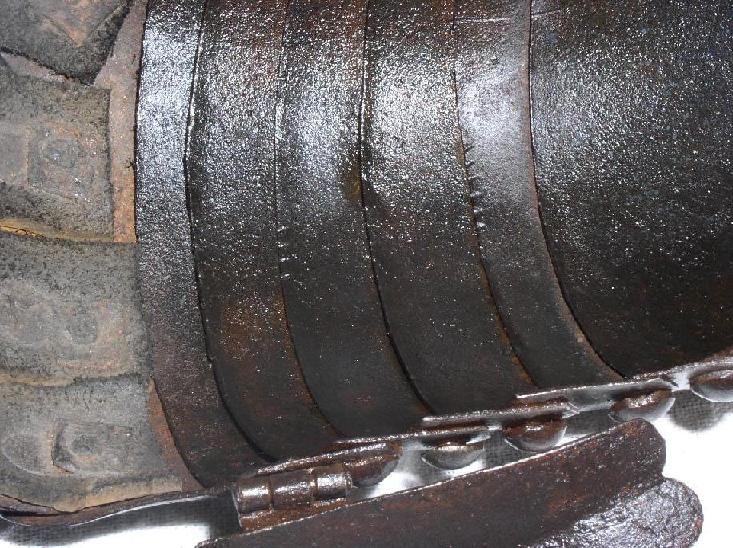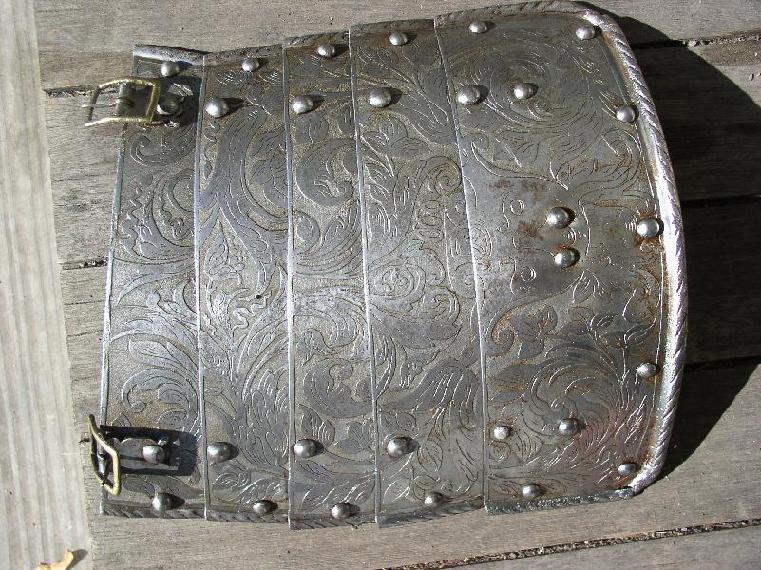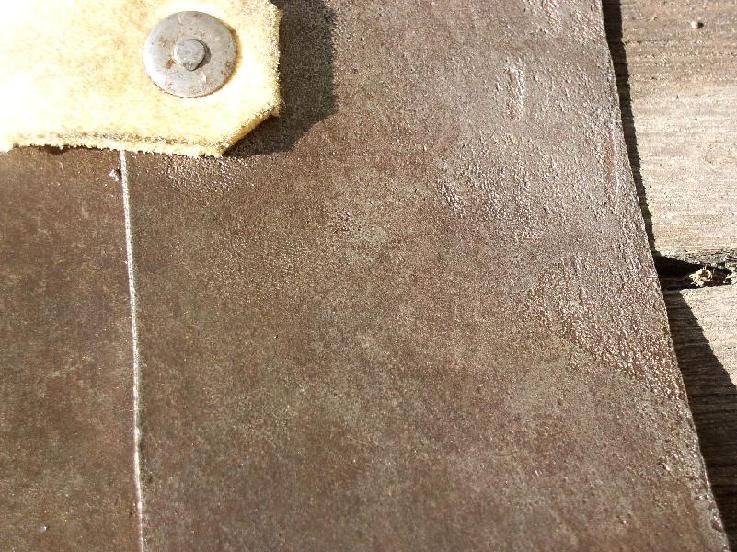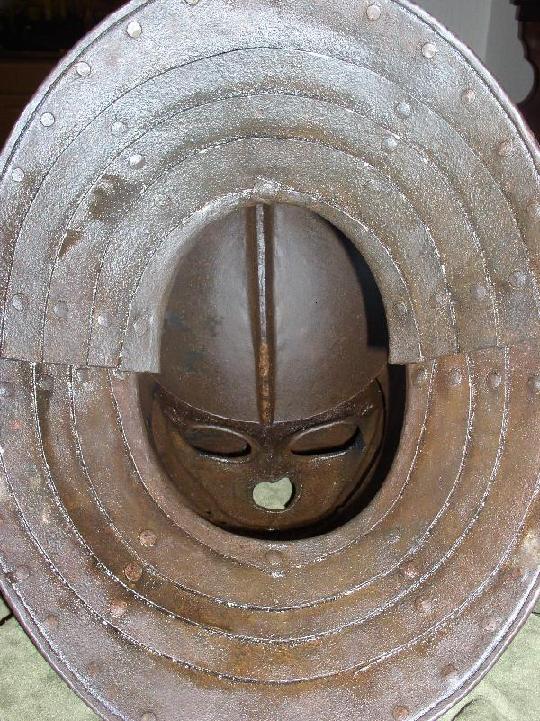| Author |
Message |
|
Allan Senefelder
Industry Professional
|
 Posted: Fri 04 Jun, 2004 7:48 pm Post subject: New period armour acquisitions Posted: Fri 04 Jun, 2004 7:48 pm Post subject: New period armour acquisitions |
 |
|
Hi guys,
We just got in a couple of new period pieces. The first pictures show fingered gauntlets circa 1560-70 and the other photos are of a gothic cuisse (right leg) circa 1490. Additional Cuisse shots in second email
 Attachment: 117.27 KB Attachment: 117.27 KB

inside gauntlet
 Attachment: 89.69 KB Attachment: 89.69 KB
both gauntlets [ Download ]
 Attachment: 109.29 KB Attachment: 109.29 KB
etching on gauntlet [ Download ]
 Attachment: 114.35 KB Attachment: 114.35 KB
thumb closeup [ Download ]
 Attachment: 112.95 KB Attachment: 112.95 KB
cuisse [ Download ]
|
|
   |
 |
|
Allan Senefelder
Industry Professional
|
 Posted: Fri 04 Jun, 2004 7:52 pm Post subject: More Cuisse shots Posted: Fri 04 Jun, 2004 7:52 pm Post subject: More Cuisse shots |
 |
|
Here are the rest of the cuisse pictures
 Attachment: 88.72 KB Attachment: 88.72 KB
inside of the cuisse [ Download ]
 Attachment: 62.98 KB Attachment: 62.98 KB
rolled edge with wire [ Download ]
 Attachment: 104.32 KB Attachment: 104.32 KB
slotting [ Download ]
|
|
   |
 |
Bill Grandy
myArmoury Team


|
 Posted: Fri 04 Jun, 2004 7:57 pm Post subject: Posted: Fri 04 Jun, 2004 7:57 pm Post subject: |
 |
|
|
Very nice looking stuff. I'm in the middle of commissioning a 15th century gothic harness with fluting, so the cuisse is of particular interest to me. Thanks for the pics!
|
|
   |
 |
David Quivey

|
 Posted: Fri 04 Jun, 2004 8:40 pm Post subject: Posted: Fri 04 Jun, 2004 8:40 pm Post subject: |
 |
|
|
Lovely, Allan! Thanks for sharing those! Those gauntlets in particular look to be in supprisingly good condition - the little I see of the leather looks fairly well preserved?
|
|
   |
 |
|
Allan Senefelder
Industry Professional
|
 Posted: Fri 04 Jun, 2004 10:13 pm Post subject: Posted: Fri 04 Jun, 2004 10:13 pm Post subject: |
 |
|
David, the finger leathers are exceedingly brittle! We're as surprised as you are at the condition. They were "Professionally
Cleaned" before we got them but an application of BreakFree got several lames that were rust locked to free up . The rivets at the cuff that would have held the glove in place have been replaced at some time probably for display purposes
as they do not exhibit the same rust pitting as the rivets in the rest of the construction. For as dry as the leather is for the fingers several of them still exhibit latteral movement ( they swing from side to side at the point where they're attached to the knuckles ) .
Bill, the strength imparted by the ridge geometry is amazing ! You can squeeze the sides in a full two inches each (you're now exerting about maximum force ) and it returns to shape every time ( sacrilege I know, but we've been doing this since we got it ) and its made from 24 gauge steel, tops ! The strength imparted by the geometry of the ridging is truly impressive !
TOYS!!
|
|
   |
 |
|
Brian M
Location: Austin, TX Joined: 01 Oct 2003
Posts: 500
|
 Posted: Fri 04 Jun, 2004 11:40 pm Post subject: Posted: Fri 04 Jun, 2004 11:40 pm Post subject: |
 |
|
Great pix! Thanks for sharing them. I'm surprised that the cuisse is 24 ga, but I guess we're conditioned to expect thicker metal (14-18g) due to the reproduction/re-enactment market. I really like the repousse (?) on the gauntlet cuffs.
Brian M
|
|
  |
 |
|
Jason Perfetto
Industry Professional
Location: Rochester Joined: 02 Mar 2004
Posts: 6
|
 Posted: Sat 05 Jun, 2004 6:13 am Post subject: Posted: Sat 05 Jun, 2004 6:13 am Post subject: |
 |
|
Brian because of the different use armour is put to today ( much heavier, fight practice every Tuesday night and a weekend long event every other weekend... that sort of thing ) modern armour is built in thicker gauges than period work . I was very
suprised at how thin the construct of period peices was myself years back when I first went to The Tower Armouries and
got to look at it close up . The gauntlets are etched in a floral spray pattern with a bird ( an eagle I think ) at the apex of each cuff . Glad you dug the pics . Oh this is Allan. Jason was logged on and happened to see your post so I just started typing .
Jason Perfetto
The Mercenary's Tailor
Armorer
|
|
  |
 |
|
Jason Perfetto
Industry Professional
Location: Rochester Joined: 02 Mar 2004
Posts: 6
|
 Posted: Sat 05 Jun, 2004 6:13 am Post subject: Posted: Sat 05 Jun, 2004 6:13 am Post subject: |
 |
|
Brian because of the different use armour is put to today ( much heavier, fight practice every Tuesday night and a weekend long event every other weekend... that sort of thing ) modern armour is built in thicker gauges than period work . I was very
suprised at how thin the construct of period peices was myself years back when I first went to The Tower Armouries and
got to look at it close up . The gauntlets are etched in a floral spray pattern with a bird ( an eagle I think ) at the apex of each cuff . Glad you dug the pics . Oh this is Allan. Jason was logged on and happened to see your post so I just started typing .
Jason Perfetto
The Mercenary's Tailor
Armorer
|
|
  |
 |
|
Allan Senefelder
Industry Professional
|
 Posted: Sat 05 Jun, 2004 7:06 am Post subject: Posted: Sat 05 Jun, 2004 7:06 am Post subject: |
 |
|
Oh Brian repousse is basically the same thing as embossing . Small chisels and punches are used to raise shapes on the outside surface of metal by working from the inside surface . Etching is of course using an acid to remove metal in
specific areas to leave a pattern .
|
|
   |
 |
Bill Grandy
myArmoury Team


|
 Posted: Sat 05 Jun, 2004 7:44 am Post subject: Posted: Sat 05 Jun, 2004 7:44 am Post subject: |
 |
|
| Allan Senefelder wrote: |
Bill, the strength imparted by the ridge geometry is amazing ! You can squeeze the sides in a full two inches each (you're now exerting about maximum force ) and it returns to shape every time ( sacrilege I know, but we've been doing this since we got it ) and its made from 24 gauge steel, tops ! The strength imparted by the geometry of the ridging is truly impressive ! |
That's really awesome. Most armor these days is so much heavier than historical counterparts, much like the sword market not too long ago. Hopefully with the broadening study of period armor this will begin to level out. Many groups (ren fairre troupes being some of the most famous) get suited up in their all 14-12 gauge armor and start whacking each other with their 10 lbs + longswords, which will of course start to dent up the armor. Many other groups aren't using steel, but an example would be SCA combat, where the intent is to hit the armor, and hit it hard, with a rattan stick. While I'm not dismissing that type of recreation, it isn't historically correct fighting, where you tried to hit someplace the armor isn't. This is why the reproduction armor world has such hefty gauges, because the market demands it.
|
|
   |
 |
|
Steve Fabert
|
 Posted: Sat 05 Jun, 2004 9:19 am Post subject: Posted: Sat 05 Jun, 2004 9:19 am Post subject: |
 |
|
| Bill Grandy wrote: | | Most armor these days is so much heavier than historical counterparts, much like the sword market not too long ago. |
I was interested to read the page at Valentine Armouries about the weight of historical pieces versus reproduction items. http://www.varmouries.com/vweights.html
This would seem to explain the popularity of fluted armor in the late 15th and 16th Centuries, since it must have been possible to trim a lot of weight off the whole kit by ridging the surfaces.
|
|
  |
 |
|
Brian M
Location: Austin, TX Joined: 01 Oct 2003
Posts: 500
|
 Posted: Sat 05 Jun, 2004 10:03 am Post subject: Posted: Sat 05 Jun, 2004 10:03 am Post subject: |
 |
|
I wonder if those gauntlets were from a "Black&White" suit originally?
Brian m
|
|
  |
 |
Gordon Frye

|
 Posted: Sat 05 Jun, 2004 11:11 am Post subject: Sweet Pieces! Posted: Sat 05 Jun, 2004 11:11 am Post subject: Sweet Pieces! |
 |
|
Allan;
Sweet Pieces you have there! VERY nice stuff! Thanks for not only posting the pictures, but the little comments about how the ribbing helps with the strength... something that we all may know on one level, but it's really, really nice to see original stuff doing just what it is "supposed to" do!
Sure looks like those Gauntlets are from a high-quality suit, too. You really scored with all of your new loot, now for you to make repro's of it! Nice Reiter-style Gauntlets coming up to the elbows, to almost reach the pauldrons, so you don't need the vambraces, rerebraces and couters, black-and-white paint job, etc... 
Thanks again for sharing!
Gordon
"After God, we owe our victory to our Horses"
Gonsalo Jimenez de Quesada
http://www.renaissancesoldier.com/
http://historypundit.blogspot.com/
|
|
    |
 |
|
Allan Senefelder
Industry Professional
|
 Posted: Sat 05 Jun, 2004 12:35 pm Post subject: Posted: Sat 05 Jun, 2004 12:35 pm Post subject: |
 |
|
Bridal gauntlets AAHHHHLLLLL....( Homer Simpson drooling noise ) . Gordon I so want to make those .
Brian , black and white armours are created by either leaving the plates black from the forge and polishing the recessed
borders and any raised repoussed points or by painting the armour black ( the painted examples i've seen used a very
thick almost stove pipe type oil paint ) and polishing the "white " areas . The darkened color of the etch on the gauntlets
is the area that was slightly eaten away by the acid used so that the design stands out in relief vs etching the design into the metal . This style of etch was very popular and quite common on 16th century armour .
|
|
   |
 |
Gordon Frye

|
 Posted: Sat 05 Jun, 2004 1:07 pm Post subject: Bridle Gauntlets Posted: Sat 05 Jun, 2004 1:07 pm Post subject: Bridle Gauntlets |
 |
|
Allan;
Well, since you seem to have some nice examples of gauntlets from the period I favor right in front of you, perhaps we should talk...
Gads, but what the heck. As they say, another day older, and deeper in debt, but gotta have more toys! Or at least complete the toy sets on hand! 
Gordon
"After God, we owe our victory to our Horses"
Gonsalo Jimenez de Quesada
http://www.renaissancesoldier.com/
http://historypundit.blogspot.com/
|
|
    |
 |
|
Allan Senefelder
Industry Professional
|
 Posted: Sat 05 Jun, 2004 4:16 pm Post subject: Posted: Sat 05 Jun, 2004 4:16 pm Post subject: |
 |
|
Gordon as soon as we get stocked up for faire and wade through the summer season there I think I will have to slot those
into the R&D schedual . I've wanted to do them for a long time but wasn't sure there was a market for them as we've primarily encountered folks with a medieval bent doing the renfaire thing .
Bill your comments regarding modern armour thickness were right on .
|
|
   |
 |
Gordon Frye

|
|
    |
 |
|
Jason Perfetto
Industry Professional
Location: Rochester Joined: 02 Mar 2004
Posts: 6
|
 Posted: Sat 12 Jun, 2004 6:17 am Post subject: We just bought a mid-16th century tasset - see the pics Posted: Sat 12 Jun, 2004 6:17 am Post subject: We just bought a mid-16th century tasset - see the pics |
 |
|
We purchased this several weeks ago and it just arrived in the mail . Points of note are the profoundly deep etching ,
and the 450 year old finger prints rust etched into the back where the tasset was held to engage the belt from the fauld with the buckles on the tasset . The leathers were badly restored ( rawhide ) and we will be replacing them . Enjoy .
Second post will be made with additional photos
 Attachment: 123.19 KB Attachment: 123.19 KB

frontal shot of tasset
 Attachment: 121.88 KB Attachment: 121.88 KB

close-up of buckle and filework on its strap
 Attachment: 74.25 KB Attachment: 74.25 KB
buckles were brass cast and filed by hand [ Download ]
 Attachment: 55.23 KB Attachment: 55.23 KB
very thick wire was used to roll over the bottom edge (for a deep countersink on the front) [ Download ]
 Attachment: 99.49 KB Attachment: 99.49 KB
washers were made by clipping pieces of metal and punching holes in them (cut washers) [ Download ]
Jason Perfetto
The Mercenary's Tailor
Armorer
|
|
  |
 |
|
Jason Perfetto
Industry Professional
Location: Rochester Joined: 02 Mar 2004
Posts: 6
|
 Posted: Sat 12 Jun, 2004 6:22 am Post subject: additional photos of the 16th century tasset Posted: Sat 12 Jun, 2004 6:22 am Post subject: additional photos of the 16th century tasset |
 |
|
Here are additional photos of the 500 year old fingerprints
 Attachment: 113.58 KB Attachment: 113.58 KB

look closely at the top right (by the corner of the strap) and you can see pitting and fingerprint swirls
 Attachment: 114.16 KB Attachment: 114.16 KB
we noticed a patina color contrast on the back of the top plate [ Download ]
 Attachment: 107.37 KB Attachment: 107.37 KB
The fingerprints are very evident here - Wow! [ Download ]
Jason Perfetto
The Mercenary's Tailor
Armorer
|
|
  |
 |
|
Allan Senefelder
Industry Professional
|
 Posted: Fri 18 Jun, 2004 8:42 pm Post subject: Posted: Fri 18 Jun, 2004 8:42 pm Post subject: |
 |
|
Jason and his credit card aquired this totenkopf helm recently . The seller wasn't sure of its origins ( Victorian or original ) . This is a highly stylized form of this helmet type with the skull motif reposed (sp) into the face of which we've only seen one other ( lost out in an auction last year ) . Based on the construction ( skull forged from one piece , ear holes ect.) it would appear to be from the early to mid17th century but because of two construction details. We think its a funery
piece . It has no liner ( and never had one, no rivet holes at all ) and the neck lames which normally would have been articulated on rivets and leathers are fix riveted so that they don't move . This is the coolest thing we've seen in a long time and it was a struggle not to shut down production to learn how to do it . Enjoy !
 Attachment: 122.88 KB Attachment: 122.88 KB

inside view of helmet - note lames on base
 Attachment: 77.54 KB Attachment: 77.54 KB
Mislocated rivet hole above left eye - typical of period pieces [ Download ]
 Attachment: 100.27 KB Attachment: 100.27 KB
close-up of skull [ Download ]
 Attachment: 83.67 KB Attachment: 83.67 KB
front view with visor open [ Download ]
 Attachment: 69.2 KB Attachment: 69.2 KB
Helmet fully open [ Download ]
|
|
   |
 |
|
|

